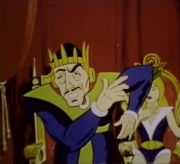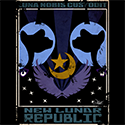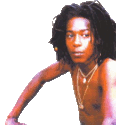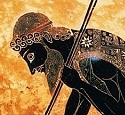|
ThatBasqueGuy posted:Was 1806 when Nappy dissolved the Hre? Yes.
|
|
|
|

|
| # ? May 10, 2024 01:18 |
|
Patrick Spens posted:I've been told that the biggest roman numeral is M, which would mean that the biggest number you could write in roman numerals is MMMCMXCIX, or 3999. So how did the romans deal with large numbers? Would they just write them out? Funny you should bring that up. Gelo II believed that the upper bound of numbers was smaller than the number of grains of sand in the world. Archimedes took offense at that.
|
|
|
|
I don't know much about Roman math (or other math) but I believe there was also a number writing system that used dots and dashes instead of letters. I could be making this up in a fever dream or it might've been Greek.
|
|
|
|
The Romans used dots and lines for fractions.
|
|
|
|
Coming from a modern perspective, how they used numbers is really baffling to me. It just seems so instinctual to say if there is another piece of grain there has to be another number to account for it. You can always add one more! It also shows how impressive the human brain is at adapting to concepts because a child can pretty quickly grasp ideas that completely eluded humanity for thousands of years.
|
|
|
|
Atlas Hugged posted:Coming from a modern perspective, how they used numbers is really baffling to me. It just seems so instinctual to say if there is another piece of grain there has to be another number to account for it. You can always add one more! It also shows how impressive the human brain is at adapting to concepts because a child can pretty quickly grasp ideas that completely eluded humanity for thousands of years. The other thing that will throw you is trying to use number systems with different bases (hexadecimal for instance). I was recently trying to explain exactly how it works to my brother, who for some computer science class was trying to figure out the decimal value of numbers in base 14. It took me much longer than I'm proud of to remember how easy it is: 23410 = 2*102 + 3*101 + 4*100 BAD14 = B*142 + A*141 + D*140 Ancient Sumerian (and later Babylonian) numbers are the textbook example of people actually using a base other than 10; they used 60 for whatever reason. That's probably why today an hour is divided into 60 units, 60 minutes of arc to a degree, etc. But they still didn't have a zero, and had weird decimal sub-bases, so it's very screwy to look at for anyone today. Also, raise your metaphorical hand if you're a nerdy kid who knows how to count to 1023 on their two hands - I do this from time to time when counting large numbers of things and it pisses people right off. PittTheElder fucked around with this message at 06:25 on Feb 14, 2014 |
|
|
|
PittTheElder posted:The other thing that will throw you is trying to use number systems with different bases (hexadecimal for instance). I was recently trying to explain exactly how it works to my brother, who for some computer science class was trying to figure out the decimal value of numbers in base 14. It took me much longer than I'm proud of to remember how easy it is: The Mayans used Base-5 IIRC.
|
|
|
Atlas Hugged posted:Coming from a modern perspective, how they used numbers is really baffling to me. It just seems so instinctual to say if there is another piece of grain there has to be another number to account for it. You can always add one more! It also shows how impressive the human brain is at adapting to concepts because a child can pretty quickly grasp ideas that completely eluded humanity for thousands of years. Romans didn't think that way in general - Gelo II was a mostly unremarkable Greek king, not a Roman, and really should have known better anyway considering Greek mathematics was already dealing with infinity and huge numbers. Romans denoted numbers higher than 4999 within the "rules" by putting a bar over numerals to represent x1000, so M-bar would be 1,000,000. You can go up to 4,999,999 this way which is much more practical. They could also almost certainly do arithmetic more or less the same way we do now with just numerals though an abacus would be desirable (since a Roman abacus was a place-value system like Arabic numerals, had a zero, etc.), and it would take longer by hand. Arabic numerals were an advancement partially because they imitate some of the characteristics of an abacus without having to have the thing with you. Societies that depended on an abacus for complicated calculations look incompetent at math now, to us, but they absolutely weren't any worse off for their dependence in terms of the end results of a calculation. Jazerus fucked around with this message at 07:48 on Feb 14, 2014 |
|
|
|
|
PittTheElder posted:Also, raise your metaphorical hand if you're a nerdy kid who knows how to count to 1023 on their two hands - I do this from time to time when counting large numbers of things and it pisses people right off. Agrippa of Nettesheim reports an even more useful method of counting, taught by the Venerable Bede: De Occulta Bk.IIch.XVI posted:When thou sayest one, bend in the litle finger on thy left hand, and set it in the middle of the Palme; when thou sayest two, place the next finger to the litle finger in the same place; when three, the middle finger after the same manner; when four, thou shalt lift up thy little finger; when five, the next to it after the same manner; when six, the middle, that finger alone which is called the ring finger, being fixt on the middle of the Palme: when thou sayest seven, thou shaly put only thy little finger above the root of thy Palm, tthe rest in the mean time being lifted up; and by it when thou sayest eight, thy ring finger; when thou sayest nine, thou shalt set thy middle finger contrary to them; when thou sayest ten, thou shall set the naile of thy fore-finger, or the middle joynt of thy thumb. When thou sayest twenty, thou shalt put the top of thy middle finger close betwixt the joynts of thy thumb, and forefinger. When thou sayest thirty, thou shalt joyn the naile of thy thumb, and fore-finger lightly together. When thou sayest fourty [forty], thou shalt bring the inside of thy thumb to the outside of thy fore-finger, both being lifted up. When thou sayest fifty, thou shalt bend thy thumb with the outward joynt like to the Greek Gamma to the Palme. When thou sayest sixty, compass about thy thumb being bended as before, with thy fore-finger bowed over it. When thou sayest seventy, thou shalt supply thy fore-finger being bowed about as before, with thy thumb stretched at length, the naile thereof being lifted up before the middle joynt of thy fore-finger. When thou sayest eighty, thou shalt supply thy fore-finger bowed about as before, with thy thumb stretched forth at length, the naile thereof being set upon the middle joynt of the fore-finger. When thou sayest ninty, thou shall set the naile of thy fore-finger bent into the root of thy thumb stretched out. Thus much for the left hand. Now thou shalt make 100. on thy right hand, as thou didst ten of thy left; and 200. on thy right, as thou didst twenty on thy left; 2000. on thy right, as thou didst two on thy left, and so to 9000. Moreover when thou sayest 10000. thou shalt put thy left hand upward on thy brest, thy fingers only being lifted towards Heaven. When thou sayest 20000. thou shalt put the same spread forth upon thy breast. When thou sayest 30000. thou shalt put thy thumb on the same hand downwards, on the cartilage of the middle of thy brest. When thou sayest 40000. thou shalt lay the same upright, and stretched forth on thy navell. When thou sayest 50000. thou shalt lay thy thumb of the same hand downard on thy navell. When thou sayest 60000. thou shalt hold thy left thigh with the same, being downards. When thou sayest 70000. the same shalt put upon thy thumb upright. When thou sayest 80000. thou shalt put the same downward on thy thigh. When thou sayest 90000. thou shalt hold thy loyns with the same, thy thumb being turned downwards. But when thou sayest 100000. or 200000. and so unto to 900000. thou shalt in the same order as we have spoken, fill them up on the right part of thy body. But when thou sayest 1000000. thou shall joyn thy hands together, and clasp thy fingers one within the other. Let these suffice which have been observed out of Beda; Thou shalt finde more of these in Brother Luke of Saint Sepulchers, in his great Arithmetick. The next chapters of the book actually discuss various notational systems used by Romans, Greeks, and others for counting large numbers. And then a few pages later he presents the names and sigils of the angels and demons of the various planets, because those are the same sort of thing as notational systems and belong in the same book. "De Occulta" is weird. Relatedly: If you want to really get culture shock from how people have thought about numbers in different eras, read the opening pages of book II of "De Occulta", where mechanical marvels are treated under the heading of "celestial magic" because creating them made use of mathematics; mathematics was linked with astrology/astronomy for most of history. John Dee's preface to the first English translation of Euclid's "Elements" is an important early modern defense of the usefulness and value of mathematical study, and it divides the subject in ways that seem crazy now: algebra and architecture are both considered "derivative" mathematical arts, and part of Dee's defense of mathematical learning is its usefulness in thaumaturgy.
|
|
|
|
I think it comes from being associated with writing, which was pretty mind-blowing to pre-literate people. This guy knows how much wheat we brought in just by looking at a piece of clay! Or alternatively, this guy figured out how to build the biggest burial mound ever... with his mind!
|
|
|
|
There is something wonderful/thaumaturgical, if you like, about the fact that all of Euclidean geometry springs from 23 definitions, 5 postulates, and 5 common notions. Or, for that matter, the fact that certain figures inherently have certain ratios to certain other figures, and that objects in our universe seem to come in the shape of those figures. It's always interesting to me to see how less materialistic ages than our own approach theoretical math.
|
|
|
|
PittTheElder posted:The other thing that will throw you is trying to use number systems with different bases (hexadecimal for instance). I was recently trying to explain exactly how it works to my brother, who for some computer science class was trying to figure out the decimal value of numbers in base 14. It took me much longer than I'm proud of to remember how easy it is: Okay, so I'm mathematically quite stupid, so bear with me, but it is my understanding that: The scientific and international communities use Base 10. Most math uses base 10. Geometry relating to circles and angular sections uses 60. Why wasn't a decimal system devised for circles/angles? Or does decimal math work in commune with base 60 because they are both divisible by 10? Is the Imperial system of measurement considered base 12 because there's 12 inches in a feet? Or is it considered to not be a "base" system since the amounts aren't fractal? (i.e. 12 inches in a foot, 12 feet in a yard, 12 yards in a mile or something) I just think it's odd that all these different mathematical forms were devised through-out history, and yet they're all still kicking around even though it seems like we should have a consistent, across-the-board standard.
|
|
|
|
Brawnfire posted:Okay, so I'm mathematically quite stupid, so bear with me, but it is my understanding that: Old habits die hard. Once everyone is used to something, it keeps being used even if something else makes more sense, as everyone is used to the old way and they fail to see the benefit of abandoning what they already know. I can visualize how long an hour is, or how heavy a pound is, or how long an inch is, so I have no need of other standards. Decimal angles and time are used routinely for scientific work. An angle of 14.392° or a time duration of 58.31 seconds are seen commonly. Scientists also abandoned Imperial units and stick exclusively with metric units. The H:M:S notation for time and angles was developed by the Babylonians a few thousand years ago, and everybody is used to it and it handles every day time notation just fine. Dividing the day into 10 time periods, and subdividing those into 10 smaller units, and so on, would work just fine. The problem is getting the public to abandon something that already works just fine, for something else that seems to offer no actual benefit - it will be rejected as not worth the bother. Deteriorata fucked around with this message at 16:43 on Feb 14, 2014 |
|
|
|
[quote="Brawnfire" post="425718526"] Why wasn't a decimal system devised for circles/angles? Or does decimal math work in commune with base 60 because they are both divisible by 10? /quote] Base 10 is natural to use because most humans have 10 fingers. Base 5 or base 20 are variations on this theme. Base 12 is actually more convenient because 12 has more divisors than 10; base 60 is even better, being evenly divisible by 2, 3, 4, 5, 6, 10, 12, 15, 20 and 30. That is extremely useful when dealing with time or angles, so the system has stuck for these use cases. There actually is a decimal system for measuring angles, where a right angle is subdivided into 100 degrees. That is what the GRAD button on a calculator is for. Zopotantor fucked around with this message at 18:16 on Feb 14, 2014 |
|
|
|
Brawnfire posted:Okay, so I'm mathematically quite stupid, so bear with me, but it is my understanding that: The fact that geometry uses units that divide into 60s doesn't really make it base 60. All the work is done in base 10, and all numbers are given in base 10. It's just that some old habits mean that there's 60 minutes in an hour, rather than there being 10 or 100 or whatever. quote:Is the Imperial system of measurement considered base 12 because there's 12 inches in a feet? Or is it considered to not be a "base" system since the amounts aren't fractal? (i.e. 12 inches in a foot, 12 feet in a yard, 12 yards in a mile or something) No, it isn't. If everything was in units of 12, then maybe you could say it was, but not really, since you're still just writing all those numbers in base 10. But of course the Imperial system is much too ridiculous for that. I hate that to properly convert miles to real units, I have to remember how many feet to a chain (66) and how many chain to a mile (80). quote:I just think it's odd that all these different mathematical forms were devised through-out history, and yet they're all still kicking around even though it seems like we should have a consistent, across-the-board standard. We've really settled in on base 10 these days. The only place other numbering systems really get used is in computing, because computers all run on binary representations (base 2), and this is more easily expressed to humans in hexadecimal (base 16).
|
|
|
|
PittTheElder posted:Also, raise your metaphorical hand if you're a nerdy kid who knows how to count to 1023 on their two hands - I do this from time to time when counting large numbers of things and it pisses people right off. Numerology is an interesting study, because in so many cases it had significant mythological and magical meanings.
|
|
|
|
Brawnfire posted:
Mostly because if you want to use a mathematically meaningful base, you'll be using radians.
|
|
|
|
Deteriorata posted:Dividing the day into 10 time periods, and subdividing those into 10 smaller units, and so on, would work just fine. The problem is getting the public to abandon something that already works just fine, for something else that seems to offer no actual benefit - it will be rejected as not worth the bother. See: the several attempts to convert the US to all metric. The best we've managed is the current state of having both systems used in different contexts.
|
|
|
|
Grand Fromage posted:See: the several attempts to convert the US to all metric. The best we've managed is the current state of having both systems used in different contexts. Or you know, the UK. Buy your gas in liters, in your car whose fuel efficiency is measured in miles per imperial gallon, then take it out on the motorway that will use meters and yards and feet for short distances and miles for long distances. The speed limit signs are of course miles per hour. And that's just for driving!
|
|
|
|
Install Windows posted:Or you know, the UK. Buy your gas in liters, in your car whose fuel efficiency is measured in miles per imperial gallon, then take it out on the motorway that will use meters and yards and feet for short distances and miles for long distances. The speed limit signs are of course miles per hour. Yeah, that was a shock to learn about after years of having British people smugly giving me poo poo for the US not using metric. You fuckers barely use it either. Anyway, point is when people are used to something, it sticks around unless the new thing is massively superior in every way. Changing time counting to base ten instead of sixty would calm some spergs but doesn't really help anything so it's not going to happen.
|
|
|
|
Grand Fromage posted:Yeah, that was a shock to learn about after years of having British people smugly giving me poo poo for the US not using metric. You fuckers barely use it either. At least we don't measure stuff for cooking in "Cups" what the gently caress even is that? Weight? Volume? Who knows! Who cares! Everyone has standardised cups right? Then again I'm just glad we decimalised currency in the 1970's, that old poo poo makes my head hurt.
|
|
|
|
Cups are volume, of course. It's 236cc. 
|
|
|
|
Cast_No_Shadow posted:At least we don't measure stuff for cooking in "Cups" what the gently caress even is that? Weight? Volume? Who knows! Who cares! Everyone has standardised cups right? Most British recipe books I have measure everything in cups. I get confused when they don't and they're asking for 200g of flour. How am I supposed to measure that?
|
|
|
|
Deteriorata posted:Old habits die hard. Once everyone is used to something, it keeps being used even if something else makes more sense, as everyone is used to the old way and they fail to see the benefit of abandoning what they already know. I can visualize how long an hour is, or how heavy a pound is, or how long an inch is, so I have no need of other standards. Yes, that's the main reason why such old ways continue. The French tried to switch to a decimal time measurement system after the Revolution/Napoleonic Era, together with the decimal system of measurement of distance, volume and weight. While weight, volume and distance caught on sooner or later, the time thing was pretty quickly abandoned as people were unable or unwilling to switch over.
|
|
|
|
Decius posted:Yes, that's the main reason why such old ways continue. The French tried to switch to a decimal time measurement system after the Revolution/Napoleonic Era, together with the decimal system of measurement of distance, volume and weight. While weight, volume and distance caught on sooner or later, the time thing was pretty quickly abandoned as people were unable or unwilling to switch over. To be fair, being able to divide time in thirds and quarters without needing decimals is really loving useful.
|
|
|
|
Octy posted:Most British recipe books I have measure everything in cups. I get confused when they don't and they're asking for 200g of flour. How am I supposed to measure that? With a kitchen scale. Most Euros I've met are a little confused that American kitchens often don't have them.
|
|
|
|
As someone who's grown up with the British hybrid system I am of the personal opinion that metric and Imperial measures each have their advantages. Clearly having everything in multiples of ten in a consistent designed scientific system makes metric superior for science/engineering etc. The Imperial system of mostly 12s and other numbers with high amounts of factors makes it useful for hands-on no fancy machines stuff. It's great to be able to divide lengths by 2 3 4 and 6 equally easily without recurring decimals. I also think having inches, feet and yards is a better distribution of sizes to estimate with than centimetres, decimetres and metres. Then again there is simply no excuse for there to be 16oz in a lb and 14lb in a st and 112lb in an Imperial hundredweight 
|
|
|
|
Kaal posted:With a kitchen scale. Most Euros I've met are a little confused that American kitchens often don't have them. I don't think kitchen scales are considered exactly a necessity in the Europe I know either.
|
|
|
|
Hey, at least decimal timescales caught on in Law, right?
|
|
|
|
Ras Het posted:I don't think kitchen scales are considered exactly a necessity in the Europe I know either. Do you also measure ingredients by volume then? How big is a metric teaspoon?
|
|
|
|
Squalid posted:Do you also measure ingredients by volume then? How big is a metric teaspoon? Uhh, as big as a teaspoon? I mean, I'm not much of a chef, but everyone around me has always used desilitre size cups for anything more than a table spoon, and all recipes have anything more than a table spoon in desilitres. "Cups" are just mystifying.
|
|
|
|
A cup is a standard measure of volume that isn't complicated. It's no different than a tablespoon, just bigger. This is roaming wildly off topic though.
|
|
|
|
Ras Het posted:Uhh, as big as a teaspoon? I mean, I'm not much of a chef, but everyone around me has always used desilitre size cups for anything more than a table spoon, and all recipes have anything more than a table spoon in desilitres. "Cups" are just mystifying. Cups are no more mystifying than liters are, its a set size (common use is simply ounce -> 8 ounces = cup -> 2 cups = pint -> 2 pint = quart -> 4 quarts = gallon; there were older units that made it so the whole thing was units that were two of the previous unit instead 8-2-2-4, such that whole system was base 2) Your tablespoons as in the cooking measure are exactly half an ounce or 1/16 a cup though, and your teaspoons are 1/3 of a tablespoon - they're a solidly non-metric measure. Incidentally 16 fluid ounces of water at a normal temperature weighs 16 ounces or one pound - it is similar to how a kilogram of water at a standard temperature is defined to be a liter of volume (and thus a gram of water at that temperature is a milliliter). Grand Fromage posted:A cup is a standard measure of volume that isn't complicated. It's no different than a tablespoon, just bigger. After reading about how for much of the middle ages the German lands in particular had a lot of cases where some government's area would be widely scattered and intermixed with areas of other government, full on enclaves and exclaves, I was wondering if any of the more local divisions of the Roman Empire in its later time periods had similar things happening. Or did the Romans prefer that all borders avoid such complications wherever possible? Nintendo Kid fucked around with this message at 17:31 on Feb 15, 2014 |
|
|
|
Grand Fromage posted:A cup is a standard measure of volume that isn't complicated.  (Sorry for the lovely iPod picture.)
|
|
|
|
Zopotantor posted:
This was actually a problem before measurements were standardized. A "tablespoon" was whatever the recipe writer's large soup spoon would hold, and would vary from spoon to spoon - sometimes even within the same house. Similarly with "cup" and "teaspoon". Reproducing old recipes is sometimes quite difficult. Also, it wasn't until the gas oven was introduced in the 1840s that decent temperature control was possible, so baking was a real adventure. Cooks would generally just start with a really hot oven in the morning and cook foods requiring progressively cooler ovens as the day progressed. Temperature was estimated based on how long it took for a piece of paper to curl and char. Relating this to ancient history, this is why for most of history people living in towns did not have ovens in their own home. It was just too much bother and wasteful of fuel to heat it up just to cook for one family. There was usually a central bakery where the ovens could be continually monitored all day long and do all the baking for everyone.
|
|
|
|
If we want to take this back to ancient history, each Greek city would have a board in the market with carvings of various bodyparts on it, to represent the city's standard 'hand' or 'foot' or whatever. You can effectively track, e.g. the cultural hegemonies circulating by looking at whose standards were adopted where.
|
|
|
|
If this measurement discussion takes up another half page, maybe the OP should change the thread title to "Ask me about ancient measurements".
|
|
|
|
What's the earliest recorded measurement?
|
|
|
|
ThatBasqueGuy posted:What's the earliest recorded measurement? Well, humans have been aware of the 'day' as a method for measuring time probably before we became fully sentient.  Scanning old Mesopotamian texts gets me something I hadn't expected. The giĝ4 or gín is made up of 60 ma-na. This isn't immediately recognisable but even thousands of years later we have the shekel made up of 60 mina. Hey, look, the 60s as a base for counting which we were talking about. Since a lot of the Near East and even the Greeks will recognise the mina as the Common Era kicks in ... I don't know that it's at all the oldest measurement - it's just something I picked out of an old Sumerian text because you might as well start there - but it's a bloody good one at lasting time. It's also demonstrative that people have wanted to measure roughly similar stuff for a very long time. The ma-na is approximated at 0.48kg and an imperial pound is 0.45kg
|
|
|
|

|
| # ? May 10, 2024 01:18 |
|
ThatBasqueGuy posted:What's the earliest recorded measurement? Man is the measure of all things.
|
|
|




 Yes, it's like a lava lamp.
Yes, it's like a lava lamp.





































